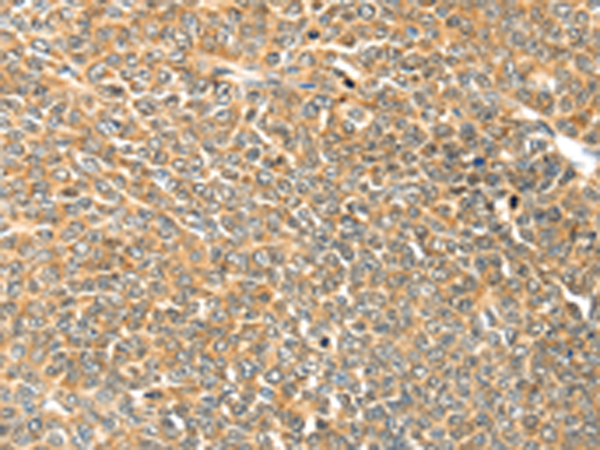
| WB | 咨询技术 | Human,Mouse,Rat |
| IF | 咨询技术 | Human,Mouse,Rat |
| IHC | 1/25-1/100 | Human,Mouse,Rat |
| ICC | 技术咨询 | Human,Mouse,Rat |
| FCM | 咨询技术 | Human,Mouse,Rat |
| Elisa | 1/2000-1/5000 | Human,Mouse,Rat |
| Aliases | OLMS; VRL3 |
| Host/Isotype | Rabbit IgG |
| Antibody Type | Primary antibody |
| Storage | Store at 4°C short term. Aliquot and store at -20°C long term. Avoid freeze/thaw cycles. |
| Species Reactivity | Human, Mouse |
| Immunogen | Synthetic peptide of human TRPV3 |
| Formulation | Purified antibody in PBS with 0.05% sodium azide and 50% glycerol. |
+ +
以下是关于TRPV3抗体的3-4篇代表性文献及其摘要概括:
---
1. **文献名称**: *"TRPV3 antibody modulates chronic itch in mice by regulating keratinocyte apoptosis"*
**作者**: Li W. et al.
**摘要**: 该研究利用TRPV3特异性抗体,在小鼠模型中证明TRPV3通过调控角质形成细胞凋亡参与慢性瘙痒。抗体阻断TRPV3活性后,显著减轻了皮肤炎症和瘙痒行为,提示其作为潜在治疗靶点。
---
2. **文献名称**: *"Development of a monoclonal antibody targeting human TRPV3 for functional studies in sensory neurons"*
**作者**: Singh A.K. et al.
**摘要**: 研究团队开发了一种针对人源TRPV3的单克隆抗体,验证其特异性及对通道活性的抑制作用。该抗体成功用于体外背根神经节神经元中TRPV3功能的调控,为痛觉机制研究提供工具。
---
3. **文献名称**: *"TRPV3 antibody-based imaging reveals skin barrier dysfunction in atopic dermatitis"*
**作者**: Cheng X. et al.
**摘要**: 通过TRPV3抗体标记技术,研究者发现特应性皮炎患者皮肤中TRPV3表达异常升高,且与屏障蛋白(如丝聚蛋白)降解相关,提示其参与疾病病理过程。
---
4. **文献名称**: *"Antibody-mediated TRPV3 inhibition reduces thermal hyperalgesia in diabetic neuropathy models"*
**作者**: Gupta R. et al.
**摘要**: 该研究证明,使用TRPV3中和抗体可显著缓解糖尿病神经病变模型中的热痛觉过敏,机制涉及TRPV3介导的脊髓胶质细胞活化抑制,为镇痛治疗提供新方向。
---
以上文献均聚焦于TRPV3抗体的开发、功能验证或疾病应用,涵盖皮肤疾病、痛觉调控等领域。
TRPV3 (Transient Receptor Potential Vanilloid 3) is a calcium-permeable ion channel belonging to the TRP vanilloid subfamily, primarily expressed in epithelial tissues, including skin, oral/nasal mucosa, and the gastrointestinal tract. It functions as a sensor for warmth (32–39°C), chemical ligands, and mechanical stimuli, playing roles in thermoregulation, skin barrier maintenance, itch, and pain signaling. Dysregulation of TRPV3 is linked to skin disorders (e.g., Olmsted syndrome, pruritus), chronic inflammation, and neuropathic pain, making it a therapeutic target.
TRPV3 antibodies are laboratory-generated tools (polyclonal or monoclonal) designed to detect, quantify, or modulate TRPV3 protein expression and activity. These antibodies are critical for techniques like Western blotting, immunohistochemistry, and immunofluorescence, enabling researchers to map TRPV3 distribution in tissues, study its activation/inhibition mechanisms, or assess its involvement in disease models. Specificity is validated using knockout controls or competitive assays. Some antibodies are engineered to block channel function, aiding in mechanistic studies or drug discovery.
Research applications span basic science (e.g., understanding TRPV3’s role in signal transduction) and translational studies (e.g., evaluating its potential as a biomarker or therapeutic target). Challenges include ensuring antibody selectivity due to homology among TRP channels. Continued development of high-affinity, isoform-specific TRPV3 antibodies remains vital for advancing studies on sensory biology, inflammatory pathways, and targeted therapies.
×